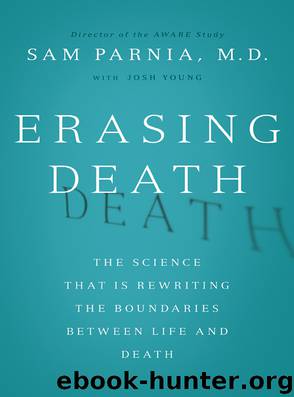Erasing Death by Sam Parnia

Author:Sam Parnia
Language: eng
Format: epub
Publisher: HarperCollins
CHAPTER 9
The Afterlife We Know
FIREFIGHTER DON HERBERT WAS battling a raging fire inside a house in Buffalo, New York, on December 29, 1995, when the roof collapsed and trapped him under a pile of smoldering debris. Minutes before he nearly burned to death, members of his ladder team rescued him by pulling him out of a window, but in many ways it was too late—Don Herbert was already undergoing anoxic brain injury from having been stuck in a smoke-filled room for too long. Biologically speaking, essentially what was happening to his brain was the exact same thing that happens after a cardiac arrest and when people die: a global stroke—a stroke that is causing progressive cell damage in the whole brain and not just a part of the brain. Although potentially reversible at first, the damage eventually becomes irreversible. Herbert was rushed to the hospital, but by the time he arrived, he had slipped into a coma. He wasn’t able to respond to any verbal commands, likely due to swelling of his brain. Although today medical interventions such as cooling may have prevented the progress from reversible to irreversible brain damage and cell death, not enough was known about it at that time, and he eventually progressed into a state of irreversible brain damage.
Though Herbert did regain consciousness for a period of time, he soon slipped back into a permanent disabled condition known as a minimally conscious state, confirming that after anoxic brain injury, a process of cell death and damage occurs over a number of hours and even days that eventually leads to irreversible brain damage and death unless an appropriate and timely intervention is made. Minimally conscious state and persistent vegetative state are two terms used to describe different points along the same spectrum of what happens to people after extensive damage to the brain areas involved with the process of consciousness and awareness. Traditionally, it has been taught that unlike a person in a vegetative state who does not exhibit any signs of consciousness, a person in a minimally conscious state, although also largely unresponsive, can muster some very limited responses to some external stimuli but is otherwise unable to perform any of the basic daily living tasks such as talking, walking, or eating without assistance from others. In short, the paradigm has always been that a minimally conscious state is a condition of severely altered consciousness in which minimal behavioral evidence of oneself or the environment is demonstrated that is completely absent in people in a vegetative state. Herbert’s situation was so severe that he could not even be fed by others so he was given a feeding tube to keep him alive. After a period of time passed with him in this condition, a neurologist determined that he would not recover, and he was placed in a twenty-four-hour nursing home.
Herbert’s case and many others like it demonstrate the devastating consequences of what happens to patients following anoxic brain injury whether from cardiac arrest and death or otherwise, without appropriate and timely interventions.
Download
This site does not store any files on its server. We only index and link to content provided by other sites. Please contact the content providers to delete copyright contents if any and email us, we'll remove relevant links or contents immediately.
When Breath Becomes Air by Paul Kalanithi(7281)
Why We Sleep: Unlocking the Power of Sleep and Dreams by Matthew Walker(5668)
Paper Towns by Green John(4180)
The Immortal Life of Henrietta Lacks by Rebecca Skloot(3838)
The Sports Rules Book by Human Kinetics(3602)
Dynamic Alignment Through Imagery by Eric Franklin(3505)
ACSM's Complete Guide to Fitness & Health by ACSM(3476)
Kaplan MCAT Organic Chemistry Review: Created for MCAT 2015 (Kaplan Test Prep) by Kaplan(3431)
Introduction to Kinesiology by Shirl J. Hoffman(3308)
Livewired by David Eagleman(3140)
The River of Consciousness by Oliver Sacks(3002)
Alchemy and Alchemists by C. J. S. Thompson(2919)
The Death of the Heart by Elizabeth Bowen(2916)
Descartes' Error by Antonio Damasio(2750)
Bad Pharma by Ben Goldacre(2738)
The Gene: An Intimate History by Siddhartha Mukherjee(2502)
Kaplan MCAT Behavioral Sciences Review: Created for MCAT 2015 (Kaplan Test Prep) by Kaplan(2495)
The Fate of Rome: Climate, Disease, and the End of an Empire (The Princeton History of the Ancient World) by Kyle Harper(2446)
The Emperor of All Maladies: A Biography of Cancer by Siddhartha Mukherjee(2441)
